The Meizu M3 Note vs. Xiaomi Redmi Note 3 Review: Comparing Notes
by Matt Humrick on July 12, 2016 8:00 AM EST- Posted in
- Smartphones
- Mobile
- Xiaomi
- Meizu
- Redmi
GPU Performance
The Meizu M3 note uses an ARM Mali-T860MP2 GPU running at up to 546MHz. This is ARM’s current mid-range offering based on its Midgard architecture. The T860 shares the same feature set as ARM’s premiere T880, but uses only 2 ALUs/core instead of 3 ALUs/core like the T880, reducing overall shader performance by up to 50%. The T860 brings hardware support for OpenGL ES 3.1 + Android Extension Pack (AEP); however, the M3 note seems to be lacking driver support for some features like tessellation.
Xiaomi’s Redmi Note 3 uses an Adreno 510 GPU running at up to 600MHz. Qualcomm does not disclose architectural details about its processors, so all we can really say for sure is that this GPU is a member of the current Adreno series along with the Adreno 530, Qualcomm’s highest-performing GPU. The Adreno 510 also supports OpenGL ES 3.1 + Android Extension Pack (AEP), and the Redmi Note 3 did not experience any compatibility issues running through our benchmark suite.
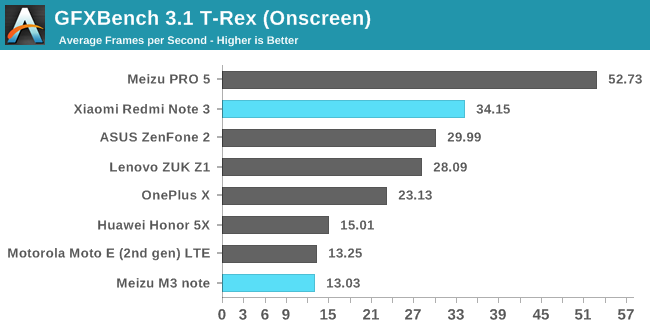
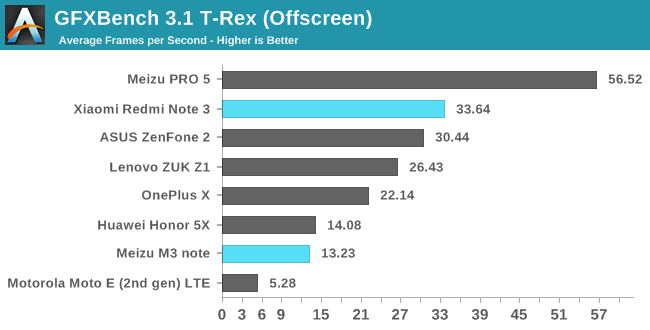
Starting with the older OpenGL ES 2.0-based T-Rex game simulation, the Redmi Note 3 separates itself from its peers, easily outperforming the M3 note by a factor of 2.5. Unlike with general system performance, the Redmi Note 3 cannot get close to the same level of performance as higher-priced flagships; the Meizu PRO 5’s Mali-T760MP8 GPU is 68% faster in this test.
The M3 note performs about the same as the Honor 5X and its Adreno 405 GPU. It will be interesting to see if this holds in our other tests. Other than the Moto E, all of the phones in the charts above have 1080p displays, so there’s no real difference between onscreen and offscreen results. The Moto E’s onscreen performance is actually the same as the M3 note’s, albeit at a lower resolution.
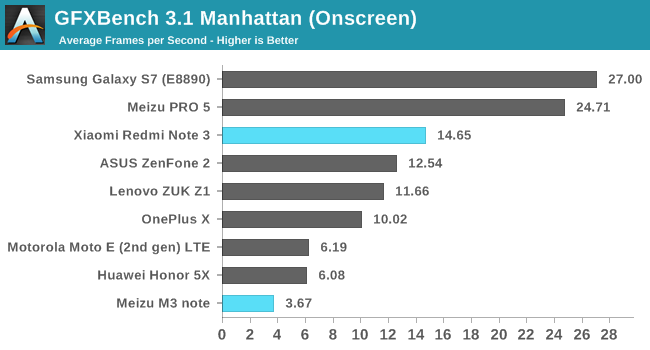
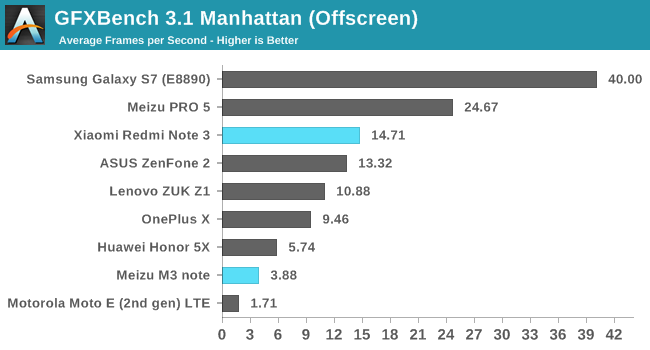

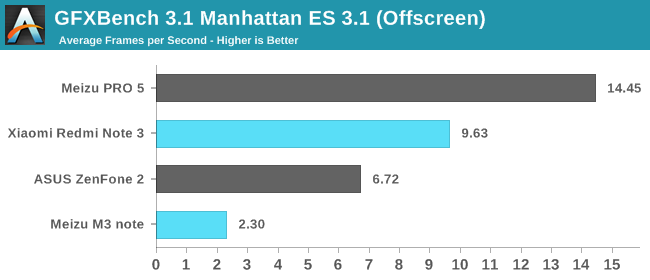
Because only two other phones in this roundup could run the GFXBench Manhattan ES 3.1 test—a point showing that both the M3 note and Redmi Note 3 are ahead of the curve when it comes to graphics API support—we’re also including the results from GFXBench Manhattan, which uses an OpenGL ES 3.0 game engine that stresses lighting and pixel effects.
In Manhattan 3.0, the Redmi Note 3 once again outperforms the non-flagship phones, managing to just stay ahead of the ASUS ZenFone 2. The M3 note falls behind the Honor 5X with a more pixel-heavy workload. It’s even slower than the Moto E’s Adreno 306 GPU when running onscreen. The T860 GPU with only two cores seems insufficient when paired with the M3 note’s 1080p display.
The Redmi Note 3 extends its lead over the ZenFone 2 when running the newer OpenGL ES 3.1 version of Manhattan, while the M3 note continues to struggle.
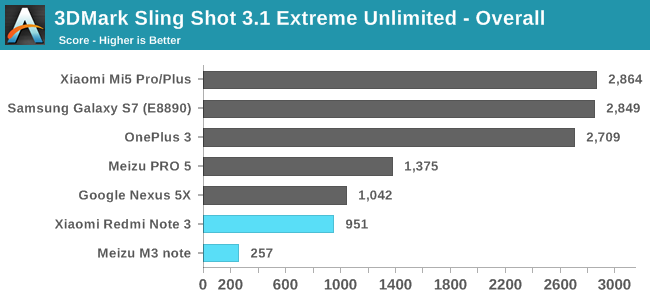
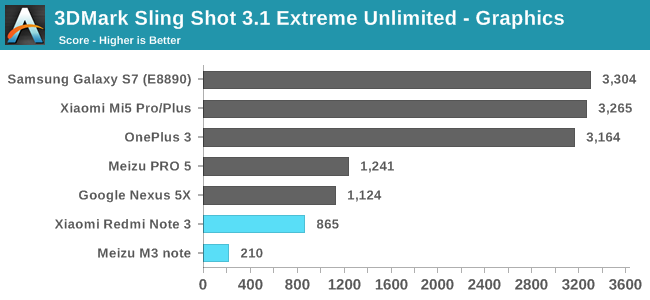
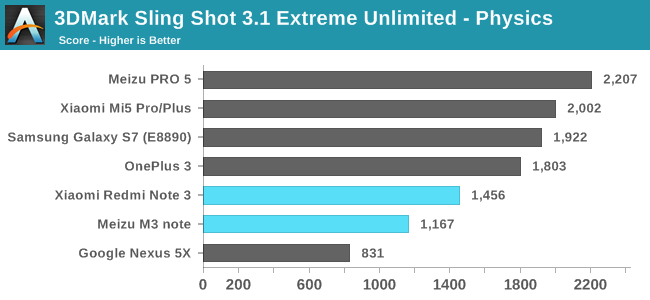
3DMark Sling Shot Extreme is another OpenGL ES 3.1 game simulation test that stresses the GPU and memory subsystems by rendering offscreen at 1440p (instead of 1080p like our other tests). This test best highlights the disparity in peak graphics performance between flagship phones and less-expensive models. The Adreno 530 GPU in the OnePlus 3 and Xiaomi Mi5, along with the Mali-T880MP12 in the Galaxy S7, delivers more than 3x the peak performance than the Redmi Note 3. The M3 note, meanwhile, really struggles at such a high resolution, falling even further behind the Redmi Note 3.
The M3 note consistently crashes when running Basemark ES 3.1, even though this OpenGL ES 3.1 test does not use tessellation. The Redmi Note 3 runs the test fine and scores the same as the Nexus 5X.
After seeing how these two phones performed during formal testing, I downloaded a few games from Google Play to see how they handled some real game code. The Redmi Note 3 loaded games more quickly than the M3 note and maintained playable frame rates in “Brothers in Arms 3,” a third-person shooter released at the end of 2014, and “CSR Racing 2,” a popular game based on OpenGL ES 3.0. There were some occasional stutters, but overall the games were playable. The chassis did get warm but not uncomfortably so.
The M3 note had no trouble keeping the frame rate above 45fps in “Angry Birds Star Wars II,” but the other two games I tried were not playable. Even at the lowest quality setting, “Brothers in Arms 3” chugged along at 8-12fps, and “CSR Racing 2” was not any better, averaging around 15fps.
Based on our testing and first-hand experience, the Redmi Note 3 should handle most games currently available. It supports the latest graphics APIs, including support for tessellation, and is powerful enough to provide an adequate gaming experience, although gameplay will not always be perfectly smooth. The M3 note, like most phones in this price range, struggles when playing more demanding games. It’s certainly fine for playing casual games, such as side scrollers and puzzles, but its two-core GPU is undersized for playing 3D content at 1080p.










79 Comments
View All Comments
serendip - Wednesday, July 13, 2016 - link
How about reviewing the Mi Max? That's a monster phone that's bigger than the old Sony Z Ultra and the cheapest variant is around 1300 yuan.djayjp - Wednesday, July 13, 2016 - link
Holy mother of god... talk about disruptive!!! The Xiaomi changes the entire industry.djayjp - Wednesday, July 13, 2016 - link
Oh wait, no LTE... ><Pissedoffyouth - Thursday, July 14, 2016 - link
Has LTE for me in the UK, just not band 20djayjp - Wednesday, July 13, 2016 - link
Why am I seeing the Redmi Note 3 coming with a MTK Helio X10??I found it listed on newegg canada
Eri Hyva - Thursday, July 14, 2016 - link
There are two different versions of Redmi Note 3, the older Mediatek version and the newer Snapdragon versionserendip - Thursday, July 14, 2016 - link
That's right, the main difference between the two versions is the network frequency support. See http://www.mi.com/note3/specs/The MTK X10 version supports FDD-LTE, TDD-LTE, TD-SCDMA, WCDMA and GSM bands. The Snapdragon version adds CDMA2000 and CDMA 1x support to that, mainly on China Telecom's CDMA network. Maybe Anandtech should amend the specs table to reflect this. You won't be able to use CDMA on North American networks though.
I'd love to see power efficiency comparisons between the Helio X10 and Snapdragon 650 when other components are the same, instead of an apples-to-pears comparison here. I'm surprised the X10 in the Meizu has a more efficient radio when on HSPA.
aliasfox - Thursday, July 14, 2016 - link
The camera section was good, but I'd like to see one more comparison, if it's possible. In addition to higher noise and underexposure in the low light shots, some of the cameras exhibited very compressed dynamic range as a result of using higher ISOs. Colors are more desaturated, highlights are more easily blown out, and shadows are more crushed.This is pretty hardware dependent, but some good exposure algorithms could mitigate it slightly.
Impulses - Thursday, July 14, 2016 - link
Having read the review in full, the Meizu is just about what I'd expect but the Xiaomi is a surprise... Shame about LTE support over here.realbabilu - Friday, July 15, 2016 - link
I think the this snapdragon 615 should be benched with 808 on G5 or mi4c for comparison